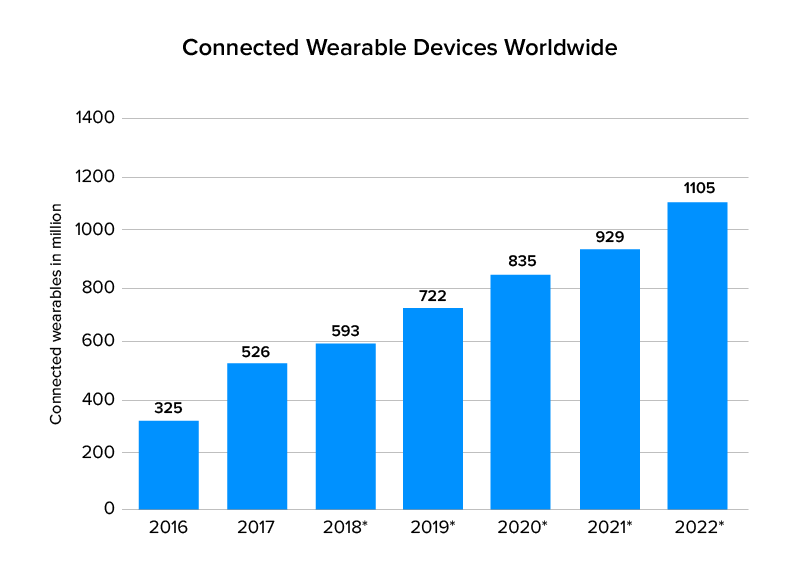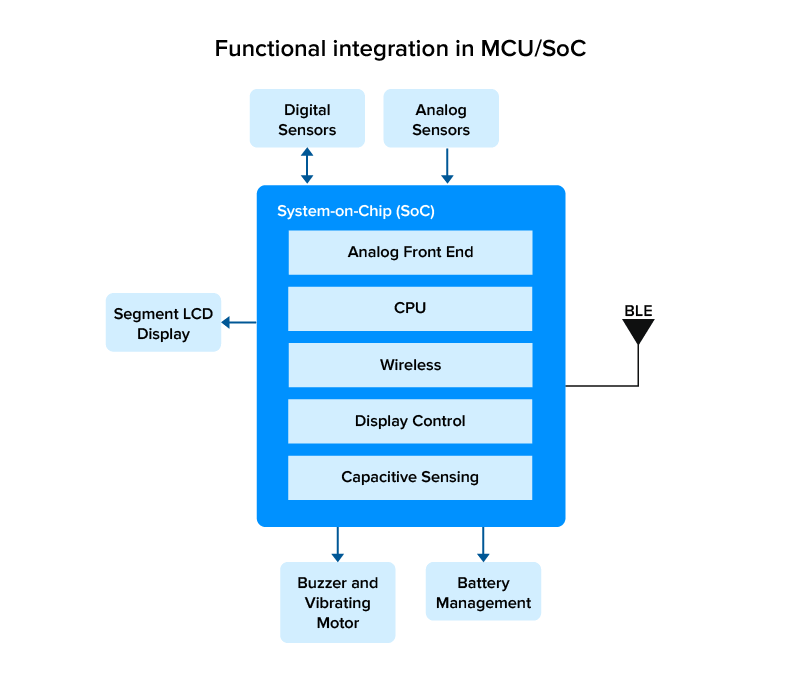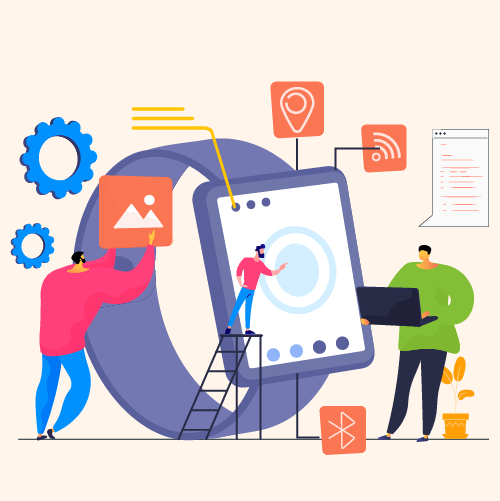An Entrepreneur’s Guide on Wearable Application Development
If you’re an entrepreneur with a revolutionary product idea, you might have already considered building a cross-platform medium of your product. However, there are high chances that wearables might not have even crossed your mind.
No matter how great your product is, if it doesn’t support basic functions such as push notifications in technology like android wear a smartwatch, smart glasses (google glass), fitness trackers, and many more; then there are chances that your customers might go to your competitors rather than waiting, suffering and becoming frustrated. This direction where the market is headed is calling for the need of developing apps for wearable devices.
With that said, wearable technology can be summarized in two simple futures – the one in which you’re living and the other in which wearable technology uses are improving your life by providing a much-required boost to your environment and surroundings at the right time.
If you think that the wearable hype is just for a few more years, then you should know that you’re living in denial. The wearable trends are emerging every year and are shaping the technological change in different ways.
These devices are going to last for long, and they’ll only get more effective and sophisticated as they evolve. With the constant use of wearable apps and gadgets, it implies that wearable apps have become a part of our daily lifestyle. As they are used by everyone on a daily basis thus, people are looking for more advancement in wearable technology, and are waiting to take the latest available hit and trial out of healthy living!
Let’s have a look at what the figures tell about this intelligent and fashionable technology:
- According to research by Statista, the total number of wearable devices connected worldwide from 2016 to 2022 is $536 million.
- The wearable technology market is expected to reach an accelerated growth of 23 percent within a year to reach over $150 billion by the end of 2026.
- By the end of 2021, the total shipments of wearable devices are predicted to reach over $560 million and are expected to provide a revenue of $95.3 billion.

As per the numbers, it’s worth saying that wearable apps are ready to modernize the world. Whether you are entering the digital space for the first time or are looking to expand your already existing digital presence, wearables are here to develop successful experiences from your creations.
Therefore, let’s cut to the chase and uncover how to get started with wearables by planning, building, and designing.
Planning Your Wearable App – Everything You Need To Know
If you’re a beginner, you’ll find wearable electronics to be the most frustrating yet fascinating technology at the same time. Apart from coding and circuit design, there are several other things that you need to consider before starting to build your wearable device apps. The task of brainstorming, getting a clear idea about the type of app that you want and types of components that you want to include, and so forth, are some of the planning ideas that need to be clear.
Let’s discuss and know how to plan properly for smooth execution.
1. Brainstorming
Before starting any project, you need an idea, a plan of how to do it, what to include, and so on. Thus, start by making a rough outline of your app and include what the app should do, how it should look, and what all to include.
Since we are just mapping out the possibilities and functionalities that should be there, thus this is the phase where you are free to use your imagination and preferred method of placing the ideas such as comparing different wearable apps and noticing the mistakes, making a list of features that are required to create a wearable app, and making a list of the users that use the feature most.
2. Collecting Data
As it is clear that wearable devices make use of user data to improve their functioning and provide accurate information to the user. Providing value to users in terms of wearable products requires context for any data that the app sensors collect. Without understanding the context of collected data, the result may be twisted or inaccurate.
Thus, to have precise data, the focus should be made on developing app sensors for android wear apps, smartwatches for iOS, and other devices.
3. Project Planning Checklist
Make a proper checklist of questions while declaring the specifics of your project. Moreover, consider adding questions such as how durable the project needs to be, whether you want to make the circuit transparent or not, who will be the user, functionalities to include for the user, and so on.
Having questions gives you an idea about the project and its developing process along with the kind of device that is to be made. For example, whether the app will be for android or iOS, such as smartwatches for iOS, android wear smartwatch, wearable web apps, and so on.
Building Your Wearable Apps – A Non-Engineer’s Guide
After you’ve done some basic prototyping with your ideas and features, you need to refine your sketch of the layout to make it even more understandable and easy to follow. In this process, you’ll also have several opportunities to find any problems with the design.
This allows you to make necessary changes before starting the app development process. A final sketch also acts as a guideline to make sure that all the features are finalized during the process to build a wearable device application. Here’s what you need to consider while building your project:
App Complexity
For example, the computation power and the machine that a smartphone uses have been designed to meet the high real-time specialized requirements. But a wearable, independent of its form is devised to deal with direct connections and not to go to a ton of computational requirements. Noticing the intrinsic contrasts, when you make a mobile application for your wearable device, you should choose which sort of apps to show in the wearable and which ones to avoid.
User Base
Since the user base is different for smartphones and wearables, thus the app making will also be different accordingly. It is important to understand and know for whom the app is being developed, what kind of app is created according to the demographic, and what necessary changes need to be made.
Security
Data is collected whether you are using smartphones or wearable devices. But the data collected from wearables are extremely critical as the information is sensitive which is according to the person’s location, health information, likes dislikes, habits, etc. Thus, for wearable app developers, it is extremely important to take care of the personal information of the user and ensure that the security remains intact when using that information.
Integration
The evolution of wearable apps has affected consumers, brands, and app developers. Businesses are empowering their administration with intuitive wearable apps development that integrate seamlessly with a wide range of connected devices and sensors.
Integrating wearable apps with multiple systems provides the ease of operating various applications with just a touch of our fingers.
For integration to succeed, the developer must start with finalizing which all data will be required for the functioning of a wearable application and then use SoC (system-on-a-chip) to native interface with number of sensors and actuators. Using API, one can share data seamlessly from different wearable devices and apps.

Prototyping
The prototype design is important to understand and know your ideas and the purpose behind a design or feature before investing time into the development.
The way the app is interacting with the users and presenting data means a lot. It should be easy and simple to understand. Too much data leads to confusion and a bad user experience. Thus, prototyping is the best option before moving forward with the development and launch.
Designing Your Wearable Apps
When it comes to wearable app development cost and procedures, there are numerous choices available in the market (including glasses, watches, rings, and wristbands) and even more, are arriving. Your app design should be made to fit with all the multitude of wearable devices, seamlessly. However, these devices have a unique set of challenges when it comes to their design. There are several limitations such as less information density, smaller screen space, and limited battery life. That’s why they require a different design approach:
1. Glanceability
Wearable designs are destined to be glanceable. For those who don’t know, the term refers to information being shown for limited interactions. A great example can be fitness trackers, that rely on lights to explain what’s happening.
2. Context
Talking about the context, it’s the backbone of your design and needs to be used to provide specific information in the least time. When you design a wearable app, you’re automatically designing for the context too because these devices are filled with sensors.
3. User Interface
When designing a wearable is important to integrate a wearable device with the existing user’s devices. Thus, wearables app development should be made keeping in mind other devices and user interface as well. For example, a blood pressure monitor and heart health app for a smartwatch might be used to gather information/data, but the review and analysis of the data collected can be made through a smartphone.

Wrapping It Up
With the growth of mobile technology, the world has seen some of the most fantastic benefits such as the ability to be available anytime, anywhere. From app development to using a wrist band, this connected technology makes everything come together and closer. AppInventiv is the most revered and reliable company for wearable app development in the US, South Asia, and European Regions. We have expertise in building world-class apps that have created new milestones.

strategies your digital product..



